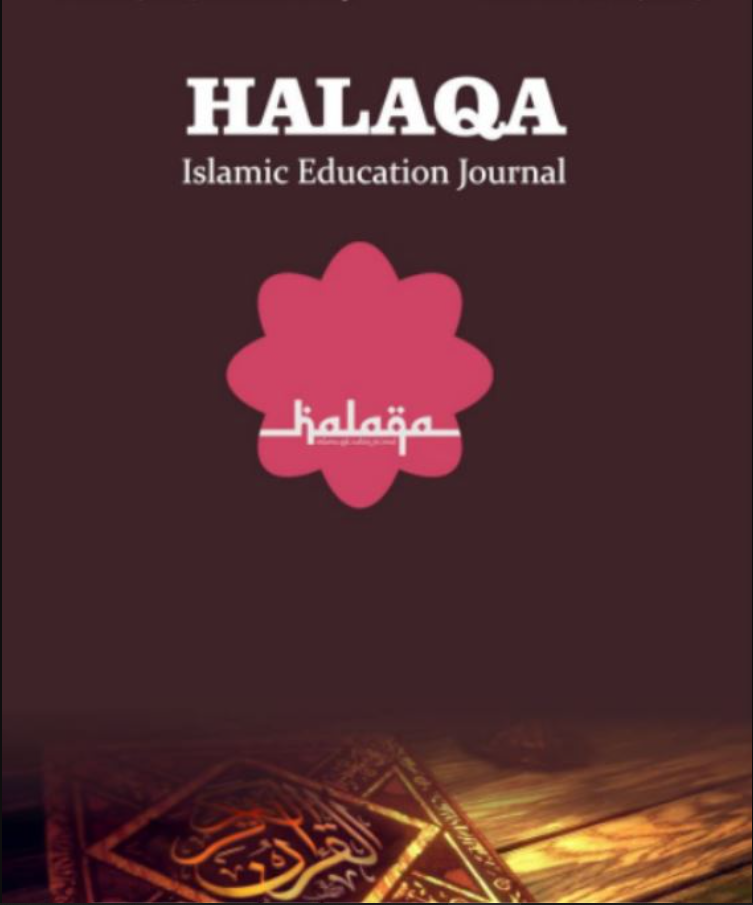Epistimology and Curriculum of Islamic Education from the Perspective of Majid 'Irsan Al-Kilani
Epistimologi dan Kurikulum Pendidikan Islam Perspektif Majid ‘Irsan Al-Kilani
DOI:
https://doi.org/10.21070/halaqa.v8i1.1677Keywords:
Epistemology, Curriculum, Islamic Education, Majid ‘Irsan Al-KilaniAbstract
The research aims to observe the perspective of Majid ‘Irsan Al-Kilani about epistemology and curriculum in Islamic education. The research used descriptive qualitative with the type of library research because of the research object and data collection. The source of data in the research was Majid ‘Irsan Al-Kilani’s books entitled Majid ‘Irsan Al-Kilani dengan judul Manāhij-ut tarbiyyat-il islāmiyyah wal murabbūna al’āmilūna fīhā, dan Falsfat-ut tarbiyyat-il islāmiyyah. Content analysis was conducted as an analysis technic in this research. Finally, this research found that epistemology in Islamic education according to Majid ‘Irsan Al-Kilani was the essence of Islamic education was an effort to lead students to reach the level “aḥsan-u taqwīm” with the tools used being revelation, mind, and the senses. Al-Kilani also concluded that the scope of Islamic education includes four aspects, namely aspects of intellectual preparation and priority of Islamic knowledge (tazkiyat i’dād-il fikriy wa taqdīm-il ma’ārif-il islāmiyyah), skill preparation aspect. Then, the concept of curriculum in Islamic education according to Al-Kilani, there were three points, as Tilawah al-Ayat, 2. Al-Tazkiyah, 3. Ta’lim al-Kitab wa al-Hikmah
Keywords: Epistemology, Curriculum, Islamic Education, Majid ‘Irsan Al-Kilani
Downloads
References
Al-Baghdadi, A. M. A. Q. (2002). Ushūl-ud Dīn. Beirut: Dar-ul Kutub-il ‘Ilmiyyah.
Al-Ghazali, A. H. (1967). Al-Munqidz Min-ad Dlalāl. Beirut: Dārul Andalus.
Al-Kilani, M. (1985). Tathawwur Mafhūm al-Nazhariyyāt al-Tarbawiyyah al-Islāmiyyah. Beirut: Dar Ibn Katsir.
Al-Kilani, M. I. (1986). Falsafat-ut Tarbiat-il Islamiyyah. Jeddah: Darul Manarah.
Al-Kilani, M. I. (1988). Ahdafu al-Tarbiyah al-Islamiyah. Medina: Maktabah Daritturas.
Al-Kilani, M. I. (1995). Manāhij-ut Tarbiyat-il Islāmiyyah. Beirut: ‘Alam-ul Kutub.
Al-Kilani, M. I. (2019). Model Kebangkitan Umat Islam Upaya 50 Tahun Gerakan Pendidikan Melahirkan Generasi Shalahuddin dan Merebut Palestina (A. Sobari, Ed.). Mahdara Publishing.
Al-Kindi. (1950). Rasā-il-ul Kindi Alfalsafiyyah. Egypt: Darul Fikr-il ‘Arabiy.
Anshari, E. S. (1979). Ilmu, Filsafat dan Agama. Surabaya: Bina Ilmu.
Assubki, T. (2003). Jam’ul Jawāmi’. Beirut: Dār-ul Kutub-il ‘Ilmiyyah.
Creswell, J. W. (2016). Research Design: Pendekatan Metode Kualitatif, Kuantitatif, dan Campuran (Edisi Kelima). Yogyakarta: Pustaka Pelajar.
Dakir, H. (2004). Perencanaan dan Pengembangan Kurikulum. Jakarta: Rineka Cipta.
Irsan A.. (2019). Majid. Retrieved from https://ar.wikipedia.org/wiki/Majid
Kartanegara, M. (2003). Pengantar Epistemologi Islam. Bandung: Mizan.
Mestika, Z. (2004). Metode Penelitian Kepustakaan. Jakarta: Yayasan Bogor Indonesia.
Naim, N. (2019). Pengantar Studi Islam. Yogyakarta: Teras.
Tafsir, A. (2013). Ilmu Pendidikan Islam. Bandung: Remaja Rosdakarya.
Edy, S. (2019). Komunikasi berbasis pendidikan karakter: Studi kritis pemikiran Ibnu Taimiyah tentang Tazkiyah Al-Nafs. At-Tanzir: Jurnal Ilmiah Prodi Komunikasi Dan Penyiaran Islam, 10(2), 148–162.
Rahman, D. A. (2023). Tantangan dan implementasi pengembangan kurikulum pendidikan agama Islam. Jurnal Studi Islam, 1(1), 10–23. https://doi.org/10.32672/si.v16i1.550
Syifa, I. W., Syafri, U. A., & Supraha, W. (2022). Konsep pendidikan Islam dalam mewujudkan gerakan Ishlah menurut Majid ‘Irsan Al Kilani. Tawazun: Jurnal Pendidikan Islam, 15(1), 85–98. https://doi.org/10.32832/tawazun.v15i1.6564
Wahid, L. A., & Hamami, T. (2021). Tantangan pengembangan kurikulum pendidikan Islam dan strategi pengembangannya dalam menghadapi tuntutan kompetensi masa depan. J-PAI: Jurnal Pendidikan Agama Islam, 8(1), 23–36. https://doi.org/10.18860/jpai.v8i1.15222
Downloads
Published
How to Cite
Issue
Section
License
Authors retain copyright and grant the journal right of first publication with the work simultaneously licensed under a Creative Commons Attribution 4.0 International License that allows others to share the work with an acknowledgement of the work's authorship and initial publication in this journal.







